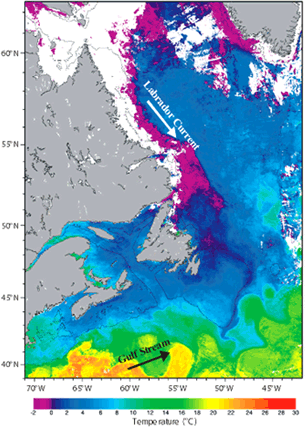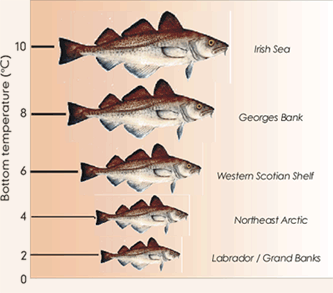
Natural Resources Canada > Earth Sciences Sector > Priorities > Climate Change Impacts and Adaptation > Climate Change in Canada
The tides of change: Climate change in Atlantic Canada The ocean
Ocean currents (see below) have a major influence on climate. The Gulf Stream carries 55 million cubic meters of water past Atlantic Canada every second at speeds up to 15 km/h. The Labrador Current transports cold Arctic water southbound at a rate of 6 million cubic metres per second, at an average speed of only 1 km/h.

In coastal areas, the white color respresents sea ice.
(Source : Department of Fisheries and Oceans, Canada) |
Fish growth rates are sensitive to water temperature

(Source : K. Drinkwater, Bedford Institute of Oceanography) |
The relative size of a 4-year-old cod from different areas around the North Atlantic including offeastern Canada. The Northeast Arctic cod are found off Norway. Note the larger size cod are found in areas with higher bottom temperature.
Sea surface temperature 1-15 May 1999 composite

(Source : Memorial University of Newfoundland) |
Did you know?
Most capelin spawn on gravel beaches. But 14 000 years ago, when sea level was lower, some capelin began to spawn on gravel beaches developed around the Grand Banks. Today, climate has changed and sea level is risen, but capelin haven't changed their habits. They still spawn on the gravel, even though it is 100 m below sea level today.

(Source : K. Drinkwater, Bedford Institute of Oceanography) |
Here we see relative sizes of four-year-old cod in different parts of Atlantic Canada. Because fish are sensitive to temperature, changing temperatures may influence distribution and population abundance of some species in the future. Population abundance will also depend on many other factors, such as food supply and predation.

(Source : Memorial University of Newfoundland) |
Did you know?
Along the coasts of Labrador and Greenland between 1900 and 1920, warmer temperatures allowed cod to move northwards. When water temperatures dropped after 1930, they retreated southwards. Similar fluctuations associated with the "Little Ice Age" in early 1800s drove the cod southwards from Iceland and Davis Strait, concentrating them in the waters of the Grand Banks. Changes in water temperature affect capelin, herring, and all species in the marine food web.
Because fish stocks are influenced by so many factors, including overfishing, a relationship between climate change and marine species cannot be easily determined.
| 